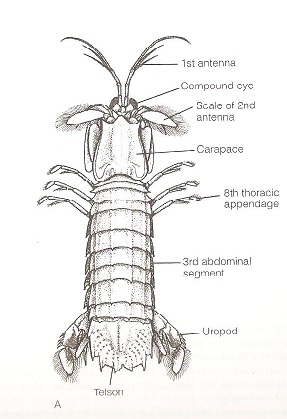External Morphology

Many of a mantis shrimp’s distinctive features are related to their raptorial behaviour. They have a dorsoventrally flattened body which is divided into a head, thorax, and abdomen (Ruppert, Fox & Barnes 2004). No cephalothorax is present (Ruppert, Fox & Barnes 2004). The head has a pair of large, stalked compound eyes and only one median naupliar eye (Ruppert, Fox & Barnes 2004). They have unusual triramous first antennae with three flagella (Ruppert, Fox & Barnes 2004). Each of the second antenna are made up of a peduncle, flagellum, and large antennal scale (Ruppert, Fox & Barnes 2004). On their dorsal side, their head and first four thoracic segments are covered by a shieldlike carapace (Ruppert, Fox & Barnes 2004). A movable median rostrum articulates with the anterior edge of this carapace and conceals the bases of the eyestalks (Ruppert, Fox & Barnes 2004). They have eight thoracic segments which bear a pair of thoracopods (Ruppert, Fox & Barnes 2004). The first of these are long and slender and are used for grooming (Ruppert, Fox & Barnes 2004). The second are subchelate, prehensile raptorial claws for capturing prey (Ruppert, Fox & Barnes 2004).
Image sourced from Ruppert, Fox Barnes (2004)

Triramous first antenna of G. chiragra
Two different types of these large raptorial appendages exist, the smasher and the spearer. The spearing stomatopod typically strikes with the dactyl in the open position, stabbing soft bodied prey such as fish on their sharp barbs (Debelius 2001). Smashing stomatopods, like Gonodactylus chiragra instead strike with the dactyl folded, hitting their armoured prey, such as crabs, powerfully with the blunt head, killing or stunning their victim into immobility (Debelius 2001). The image below shows the clear difference between the two types of claws, the smasher being on the left and the spearer on the right.

Thoracopods three, four and five are also subchelate but are much smaller than the raptorial claws (Ruppert, Fox & Barnes 2004). Thoracopods six, seven and eight are rather unspecialised walking legs (Ruppert, Fox & Barnes 2004). Mantis shrimp have a well-developed, muscular abdomen and five pairs of biramous pleopods with filamentous gills (Ruppert, Fox & Barnes 2004). Abdominal gills, such as these, are unusual in Crustacea, but are also found in isopods (Ruppert, Fox & Barnes 2004). The sixth abdominal segment holds a pair of uropods and a considerable telson. These together create a fan tail (Ruppert, Fox & Barnes 2004).
Mantis shrimps have superior compound eyes to any crustacean which are unique in structure (Ruppert, Fox & Barnes 2004; Cronin, Marshall & Land 1990). Stomatopods are able to distinguish moving objects as well as depth perception (Ruppert, Fox & Barnes 2004). The antennae are used for chemoreception and can also be used in prey detection when prey is close enough (Ruppert, Fox & Barnes 2004).
The Gonodactyloidea family contains the species which have eyes with the most mobility and the greatest functional specialisation (Cronin, Marshall & Land 1990). Midbands in the compound eyes in this family of stomatopods contain 6 parallel ommatidial rows, which are each structurally distinct from one another (Cronin, Marshall & Land 1990). The structural specialisations may allow only this part of the retina to complete a meticulous analysis of the spectral and polarisational content of light (Cronin, Marshall & Land 1990). The other parts of the retina, which include the majority of the whole visual field, are more like the retinae of other crustaceans, as they still have extensive spatial coverage but more restricted abilities to analyse for wavelength or polarisation (Cronin, Marshall & Land 1990). The gonodactyloid’s compound eyes are able to move on all 3 rotational axis (Cronin, Marshall & Land 1990). The ability to stabilise an eye in all 3 axes requires a flexible control system (Cronin, Marshall & Land 1990). The ability of this family to move their eyes independently, implies even greater complexity within this system (Cronin, Marshall & Land 1990).

Magnified compound eyes of G. chiragra

Magnified eyes at the end of their eyestalks in G chiragra
|